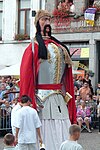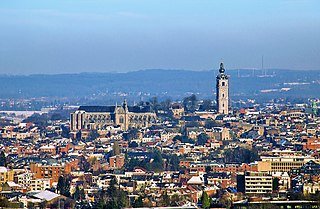
Mons is a city and municipality of Wallonia, and the capital of the province of Hainaut, Belgium.

Wallonia, officially the Walloon Region, is one of the three regions of Belgium—along with Flanders and Brussels. Covering the southern portion of the country, Wallonia is primarily French-speaking. It accounts for 55% of Belgium's territory, but only a third of its population. The Walloon Region and the French Community of Belgium, which is the political entity responsible for matters related mainly to culture and education, are independent concepts, because the French Community of Belgium encompasses both Wallonia and the bilingual Brussels-Capital Region but not the German-speaking Community of Belgium.

Belgian culture involves both the aspects shared by all Belgians regardless of the language they speak and the differences between the main cultural communities: the Dutch-speaking Belgians (Flemish) and the French-speaking Belgians. Most Belgians view their culture as an integral part of European culture.

Ath is a city and municipality of Wallonia located in the province of Hainaut, Belgium.
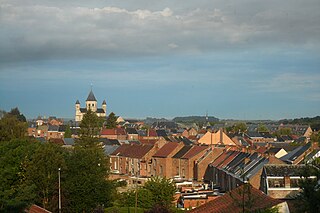
Nivelles is a city and municipality of Wallonia located in the Belgian province of Walloon Brabant. The Nivelles municipality includes the former municipalities of Baulers, Bornival, Thines, and Monstreux.
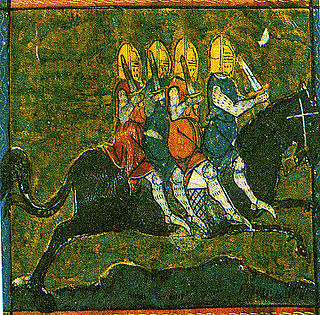
Bayard is a magical bay horse in the legends derived from the medieval chansons de geste. These texts, especially that of The Four Sons of Aymon, attribute to him magical qualities and a supernatural origin. He is known for his strength and intelligence, and possesses the supernatural ability to adjust his size to his riders.

Processional giants are costumed figures in European folklore, particularly present in Belgian, French, Portuguese, Spanish, and English folkloric processions. The main feature of these figures is typically their wooden, papier maché or -more recently- synthetic resin head, whilst bodies are covered in clothing matching the costume's theme.

A medieval pageant is a form of procession traditionally associated with both secular and religious rituals, often with a narrative structure. Pageantry was an important aspect of medieval European seasonal festivals, in particular around the celebration of Corpus Christi, which began after the thirteenth century. This festival reenacted the entire history of the world, in processional performance, from Bible's Genesis to the Apocalypse, employing hundreds of performers and mobile scenic elements. Plays were performed on mobile stages, called waggons, that traveled through towns so plays could be watched consecutively. Each waggon was sponsored by a guild who wrote, designed, and acted in the plays.

Ommegang or Ommeganck is the generic name for various medieval pageants celebrated in the Low Countries.

The Carnival of Binche is an annual festival held in Binche, Hainaut, Belgium, during the Sunday, Monday, and Tuesday preceding Ash Wednesday.

The Ducasse de Mons, also commonly known as the Doudou, is a traditional folk festival held in Mons, Hainaut, Belgium, on Trinity Sunday. The feast comprises two important parts: the procession, including the descent and the uprising of the Saint Waltrude's shrine, as well as the combat named Lumeçon between Saint George and a dragon. Since 2008, it is recognised as a Masterpiece of the Oral and Intangible Heritage of Humanity by UNESCO.

Saint-Python is a commune in the Nord department in northern France. It was named after Piatus of Tournai. Its inhabitants are called Saint-Piatiens or Piatonnais.

The Ros Beiaard of Dendermonde, Belgium, is a large folkloristic horse and the main character in the Ommegang van Dendermonde, a traditional folk festival held in that city. It is used only once every ten years and it is carried by members of a local guild, the Pijnders. Traditionally, four young brothers from Dendermonde ride the horse in full armour.
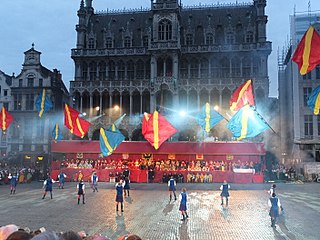
The Ommegang of Brussels is a traditional Ommegang, a type of medieval pageant, celebrated annually in Brussels, Belgium.
The Folklore of Belgium is extremely diverse and reflects the rich legacy of cultural and religious influences which have acted on the region throughout its history, even before the establishment of the nation of Belgium in 1830. Much of Belgian folklore is unique to the region in which it is commemorated. Many aspects of folklore are manifested in public processions and parades in Belgian cities; traditions which are kept alive for the amusement of locals and tourists alike.
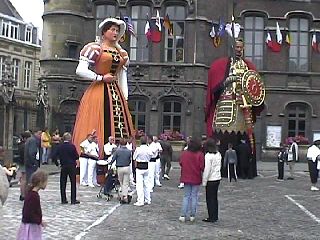
Gayant is a processional giant that symbolizes the city of Douai. It is carried through the city for three days each year at the beginning of July as part of an eponymous festival alongside its "wife", Marie Cagenon, and their three "children", Jacquot, Fillon, and Binbin. The family arrives at the belfry at Douai on the final Sunday of the festival, which culminates with Le Grand Cortège in the afternoon.

The processional giants and dragons of Belgium and France are a set of folkloric manifestations involving processional giants, which have been inscribed by UNESCO on the lists of Intangible Cultural Heritage in 2008, originally proclaimed in November 2005.
Christian Cannuyer is a Belgian historian of religion, professor at the Lille Catholic University, a specialist in Coptic studies and a genealogist.
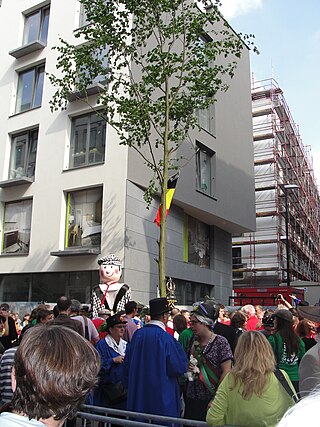
The Meyboom plantation is the oldest tradition in Brussels, Belgium, attested since 1308. It is held every year on 9 August, the eve of St Lawrence's Day, and consists mainly in planting a beech at the intersection of the Rue des Sables/Zandstraat and the Rue du Marais/Broekstraat in the City of Brussels' Marais–Jacqmain District. It is accompanied by processions and various folk activities during the day.

The Hôtel Goblet d'Alviella is a hôtel particulier designed by Octave van Rysselberghe on the Rue Faider/Faiderstraat in Saint-Gilles, Brussels, Belgium. It is the first major realization by Van Rysselberghe, who himself lived here until 1888. After that, the client, Count Eugène Goblet d'Alviella, professor, liberal member of parliament and freemason, moved in.


